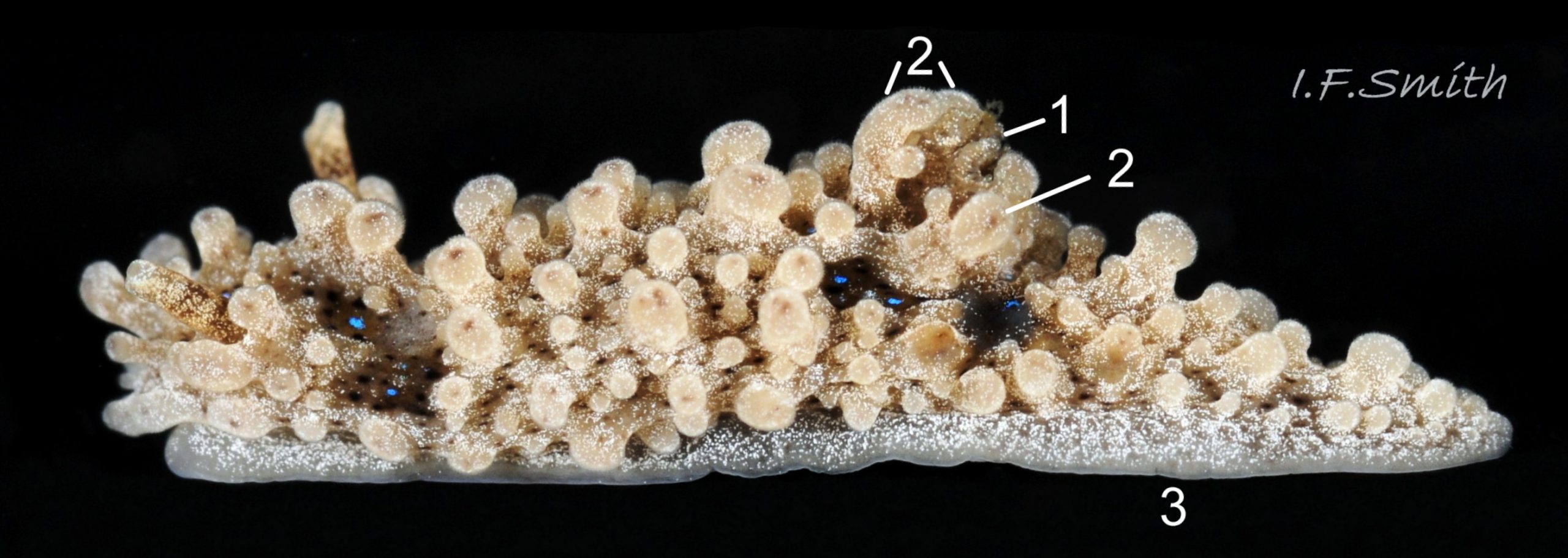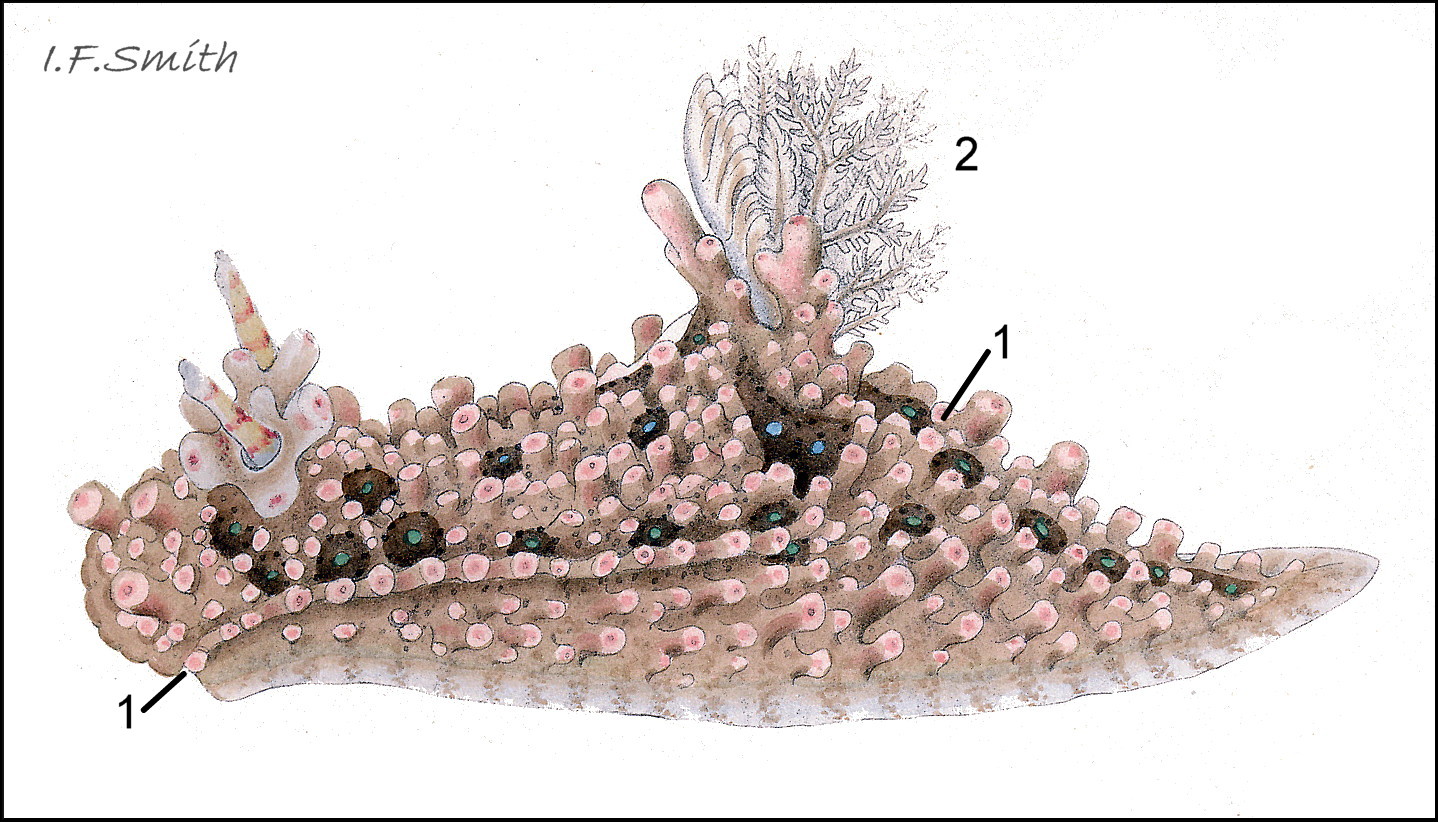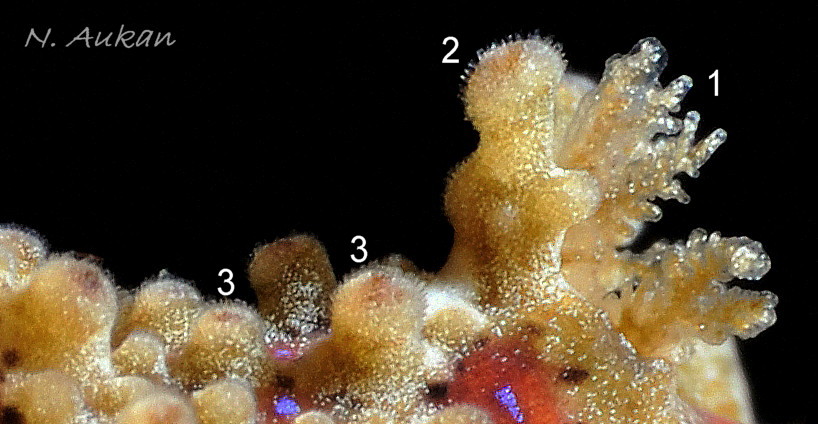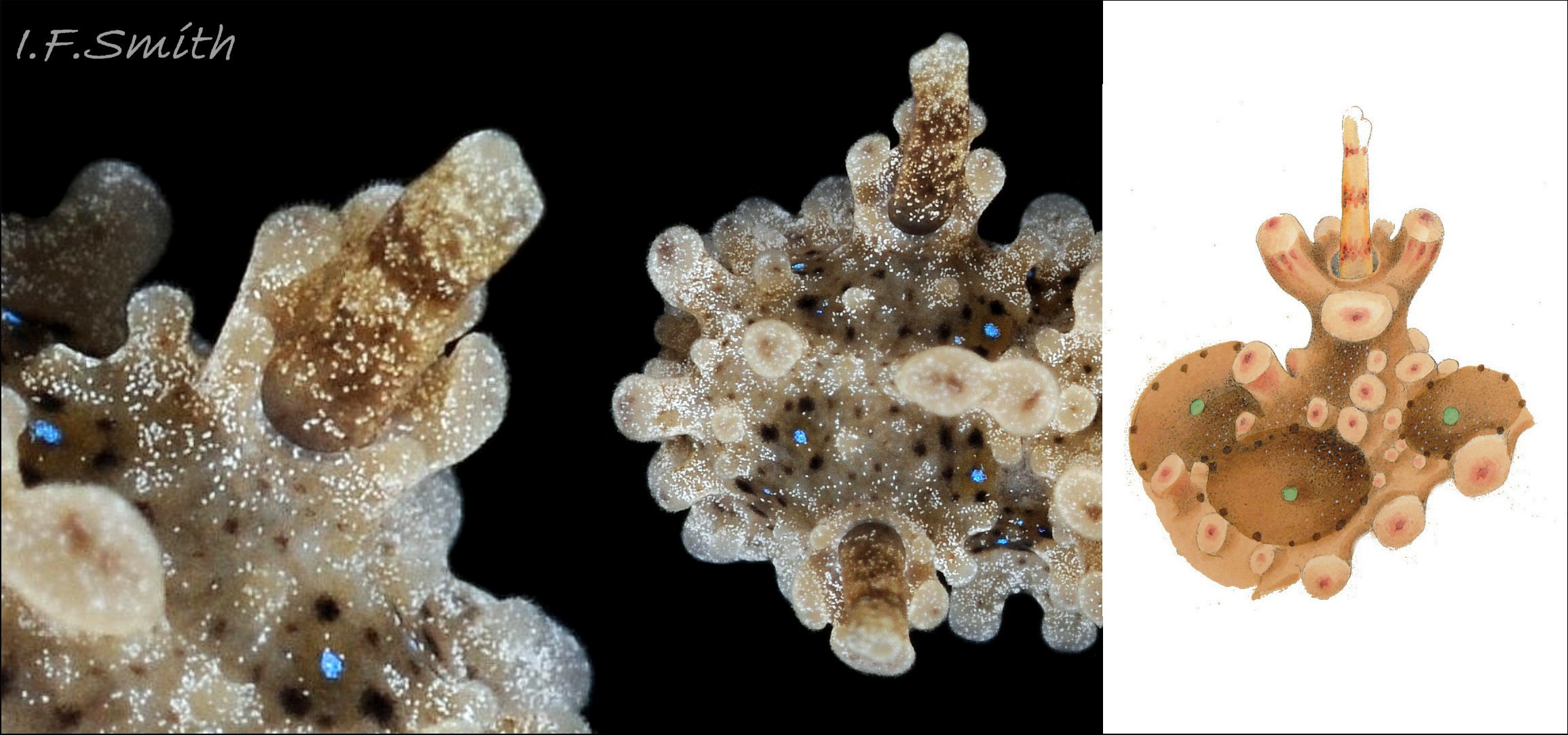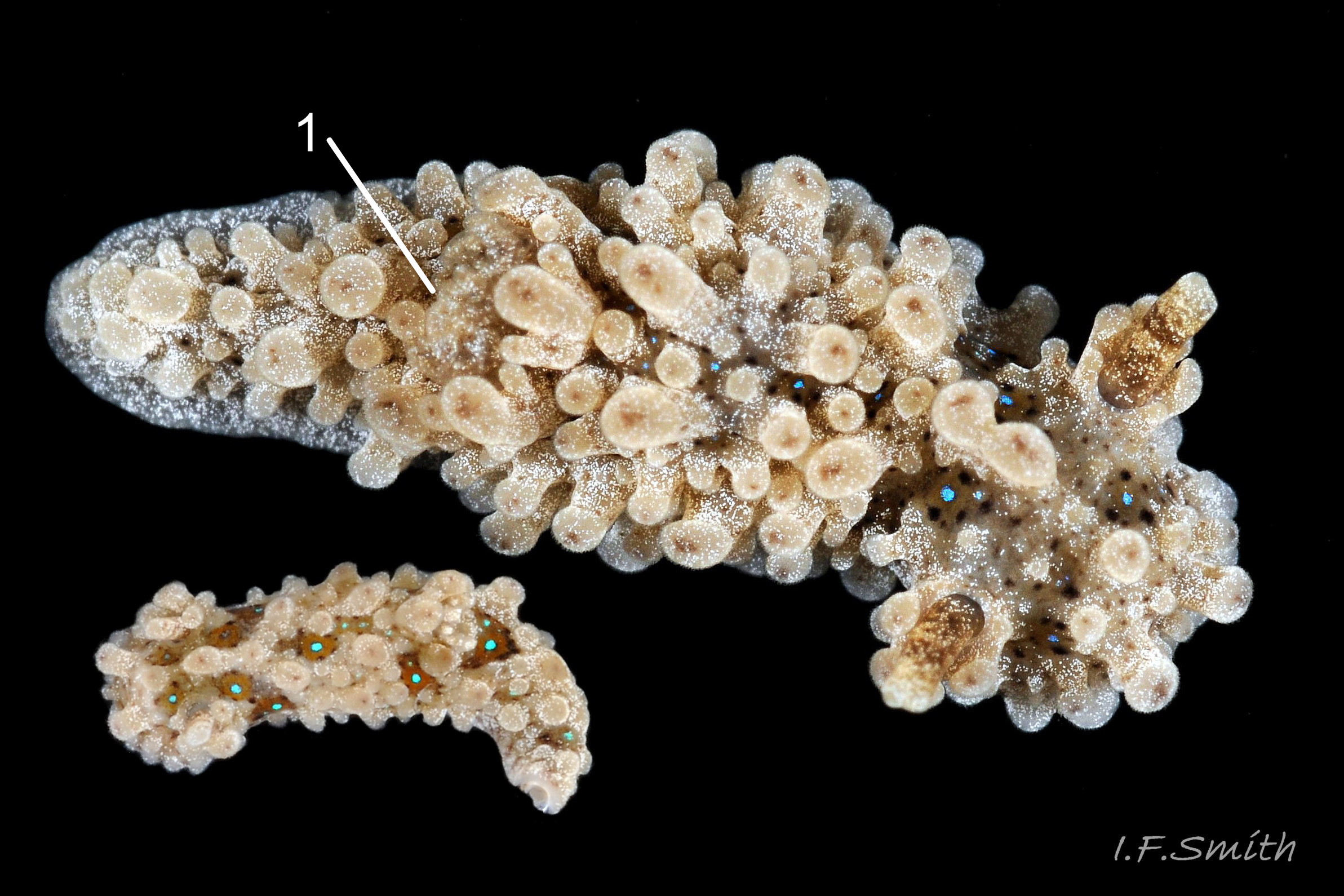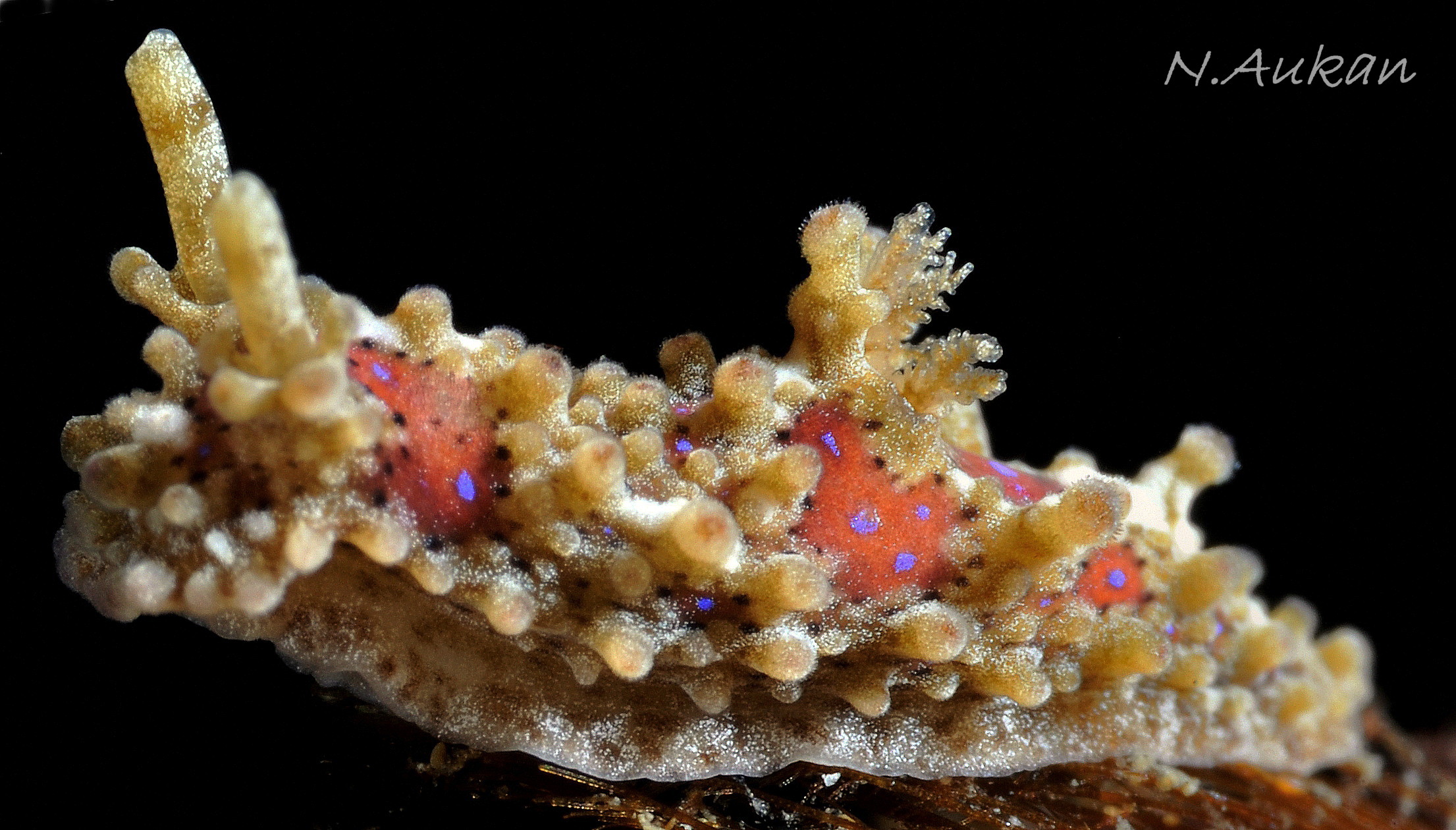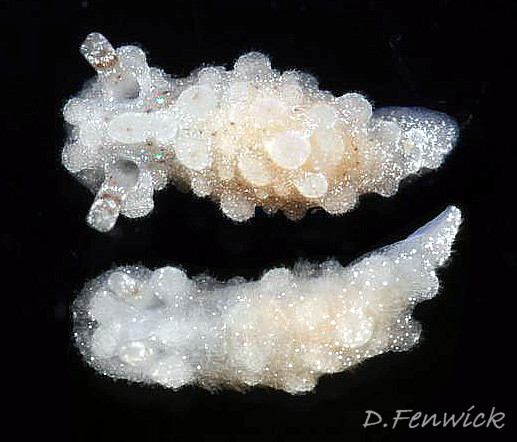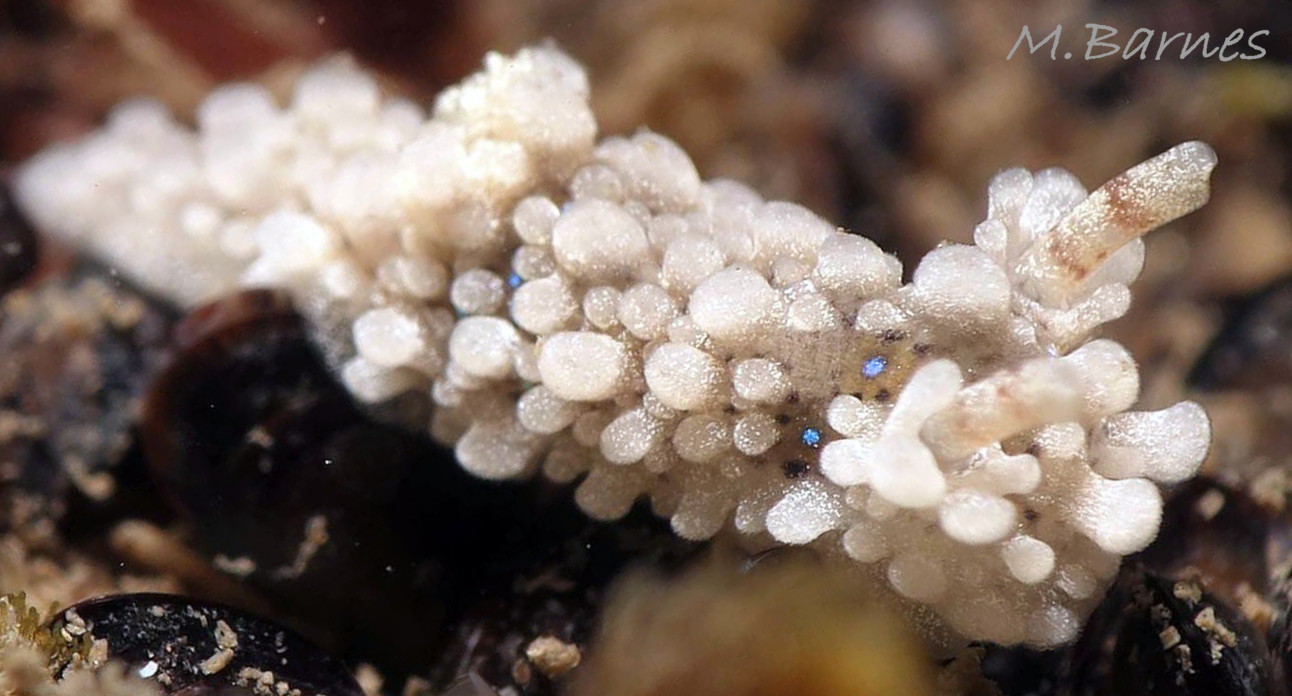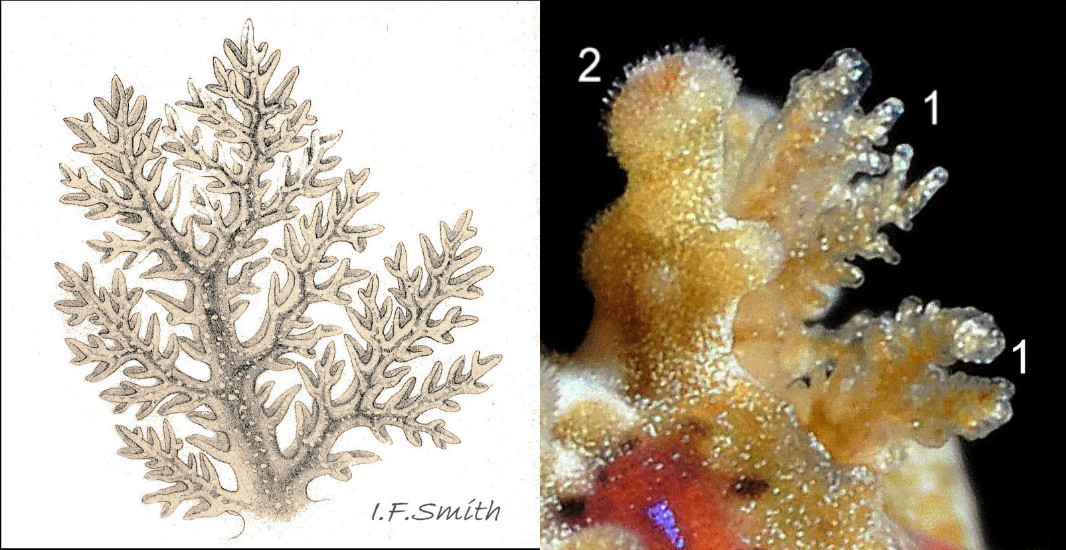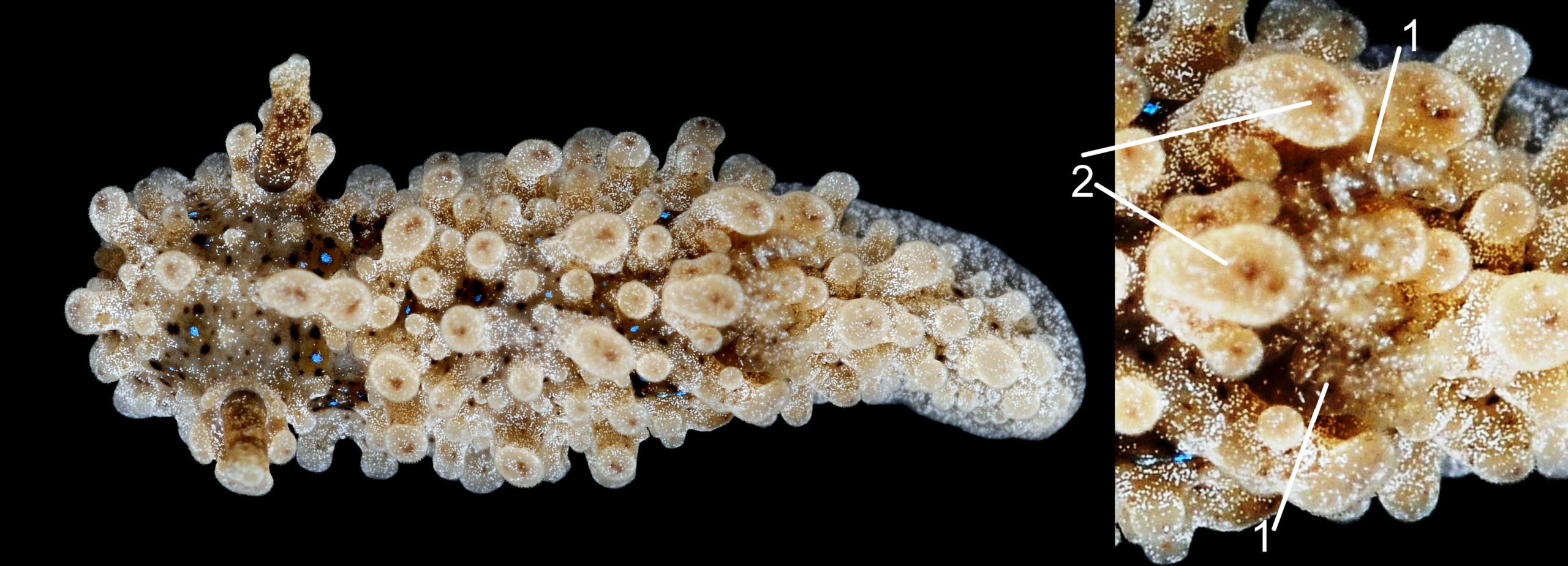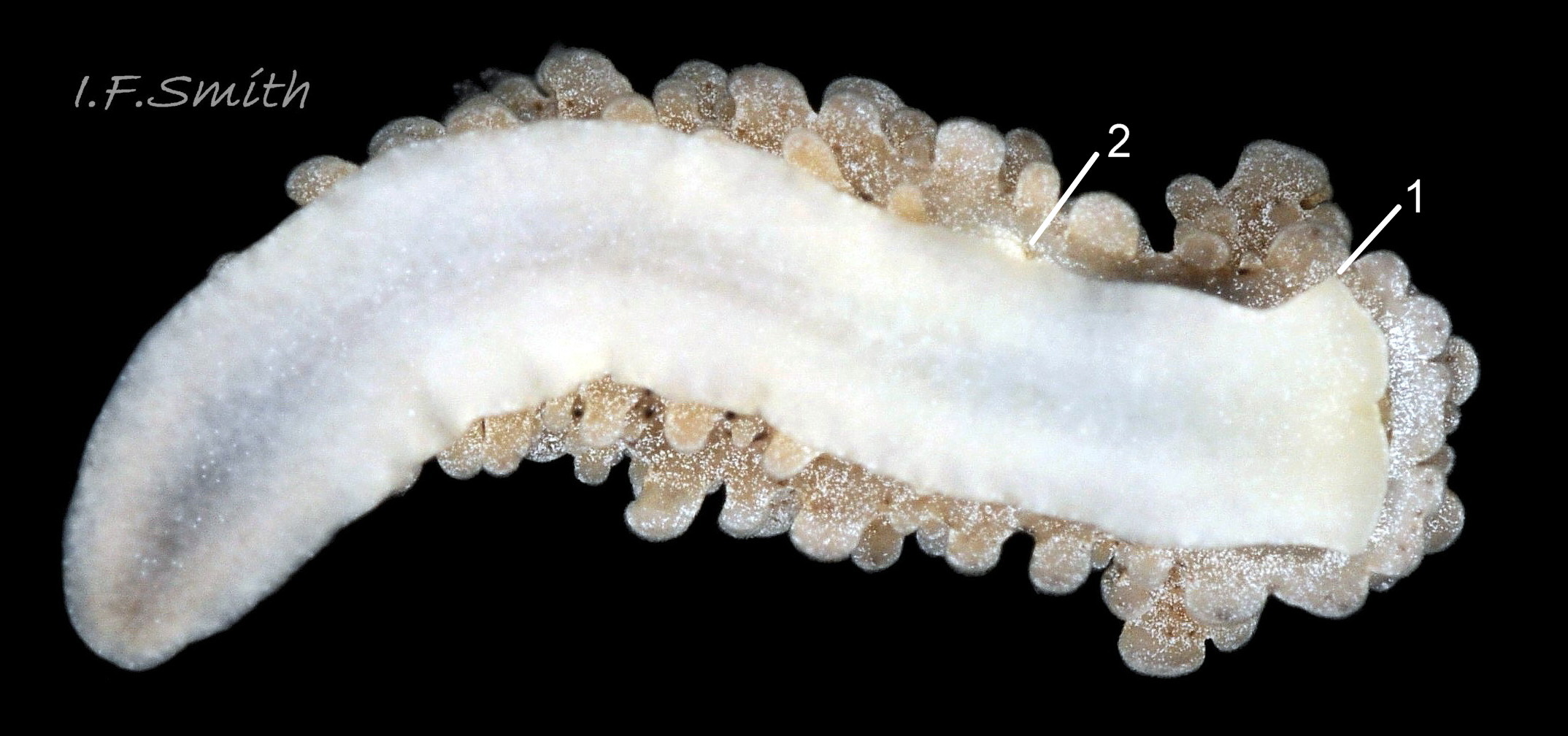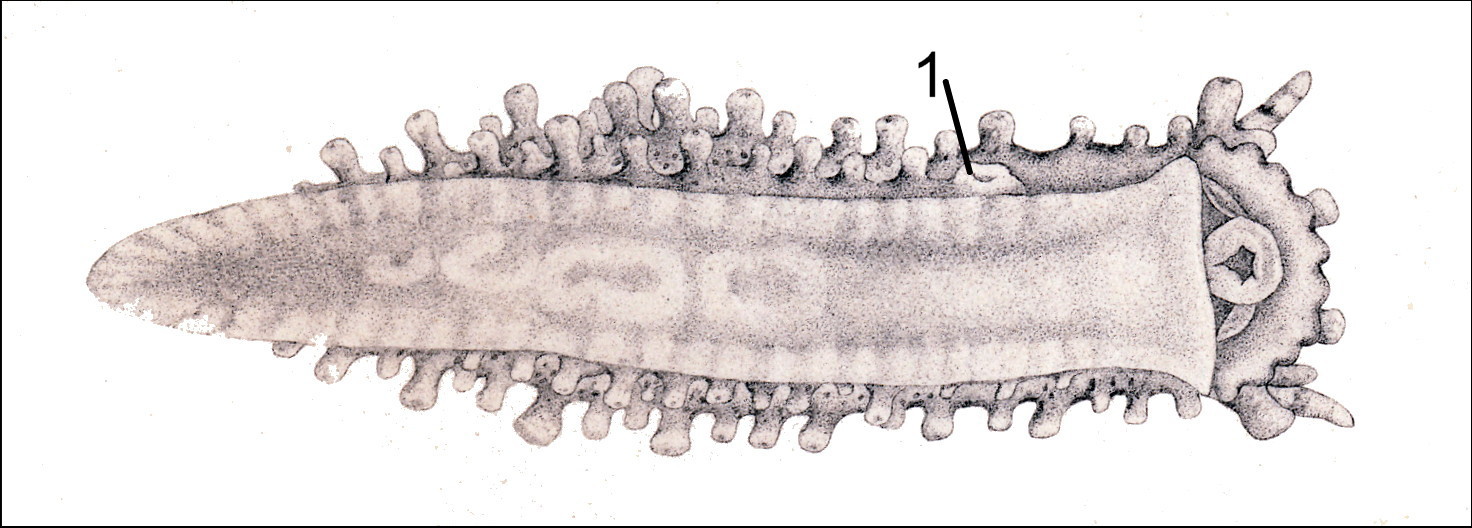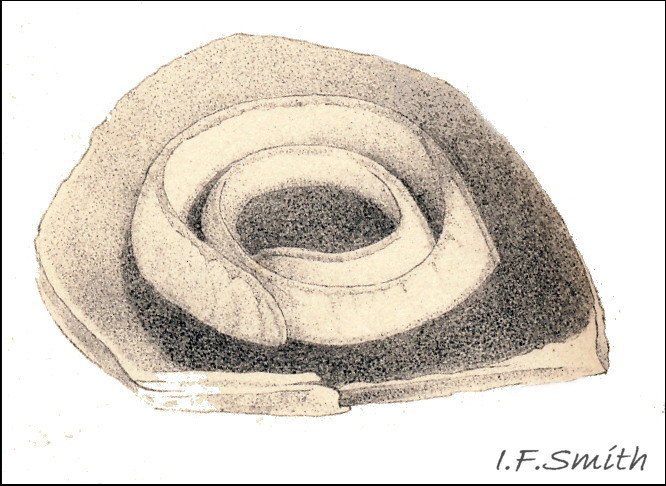Click image to enlarge with full caption. Main text below slider.
Aegires punctilucens (d’Orbigny, 1837)
PDF AVAILABLE at www.researchgate.net/publication/359467355_Aegires_puncti…
Current taxonomy: World Register of Marine Species www.marinespecies.org/aphia.php?p=taxdetails&id=138706
Synonyms: Polycera punctilucens d’Orbigny, 1837; Doris maura Forbes, 1840.
GLOSSARY BELOW
Description
Aegires punctilucens grows up to 20 mm long. The dorsal surface is densely covered with large, soft, spiculate, club shaped tubercles with expanded, flat topped heads. Each tubercle has an apical red-brown or black spot 01 Aegires punctilucens . Alder & Hancock (1845-55) stated that the tubercles on the sides are arranged in lines, with the most distinct running from the side of the oral veil to the midline of the tail marking the edge of the inconspicuous reduced mantle. This is visible on their drawing 02 Aegires punctilucens , but can usually only be discerned on those with small tubercles fig. . Protruding spicules and crowded, minute white spots on the tubercles cryptically soften their outline 03 Aegires punctilucens . The dorsal ground colour is buff to brown with spots of white and dark brown. There are several discs of red-brown, of variable size and colour intensity, with about six black-brown peripheral spots and a brilliant central spot iridescing between azure blue and emerald, as the light varies 04 Aegires punctilucens . The size and colour of the discs varies 05 Aegires punctilucens ; on many Norwegian specimens they are ruby-red, large and coalesced 06 Aegires punctilucens . Earliest stage juveniles have undeveloped tubercles and lack pigment other than fine white specks 07 Aegires punctilucens . As they grow, dark bands on the rhinophores and some iridescent spots and brown marks begin to appear. Some adults remain generally white, but have brown on the rhinophores and red-brown discs with peripheral dark dots and central iridescent spot 08 Aegires punctilucens
The rhinophores are slightly laterally compressed, smooth cylinders, with a truncate apex, arising from a cylindrical sheath 04 Aegires punctilucens . There is a tall guard tubercle on the distal, anterior and posterior rim of the sheath. The rhinophores are similar in colour to the body, with dark brown forming two or three weakly defined transverse bands.
Three tripinnate gills 09 Aegires punctilucens are on the highest point of the dorsum 02 Aegires punctilucens & 05 Aegires punctilucens . They have small white flecks and brown marks as on the tubercles, but are less discernible because they are translucent. They do not retract into a cavity, but are often contracted, and concealed by three large, three-pronged, lobes and, consequently, difficult to discern 01 Aegires punctilucens & 10 Aegires punctilucens .
Viewed ventrally, the head 11 Aegires punctilucens consists of a tubular mouth with small rounded oral tentacles in the space between the foot and an anterior veil of eight to ten tubercular, pale buff, sprinkled with white, lobes.
The foot has a slightly-translucent, white- cream sole. There are no propodial tentacles, but the corners of the truncate propodium are produced into sharp angles 12 Aegires punctilucens . The dorsal surface of the foot 01 Aegires punctilucens is translucent white, densely sprinkled with opaque white. The hermaphrodite genital aperture is behind the right rhinophore, low down below the tuberculated area 12 Aegires punctilucens & 13 Aegires punctilucens .
Key identification features
A. punctilucens
Brilliant iridescent azure blue/emerald green spots in red-brown discs.
No other north European member of the Polyceroidea has this feature.
Habits and ecology
A. punctilucens lives at lower levels of rocky shores and sublittorally at shallow depths, occasionally to 100 m depth. It feeds on the calcareous sponge Leucoselenia botryoides. Its broken outline and colours make it difficult to detect on the shore.
It is a simultaneous hermaphrodite. Spawning has been recorded in June in the Irish Sea and Mediterranean and July in Scotland (Thompson & Brown). The spawn mass is a ribbon attached to the substrate by its edge in a spiral of about two turns (Alder & Hancock, 1845-1855) 14 Aegires punctilucens . The small white ova are about ten abreast across the ribbon; the whole mass contains about 1500 (Thompson and Brown, 1984). Veliger larvae live as plankton before metamorphosing. Early stage, white juveniles of 2 or 3 mm length with partially developed tubercles have been recorded in Cornwall, England in August and October 07 Aegires punctilucens .
Distribution and status
A. punctilucens is recorded from mid Norway to the western Mediterranean. GBIF map www.gbif.org/species/2292154 . Records from the Indo-Pacific may be misidentifications of the similar Aegires exeches (Rudman).
It is widespread around Britain and Ireland, but scarce or absent in south-east England from Flamborough Head to the Isle of Wight. U.K. map.NBN species.nbnatlas.org/species/NHMSYS0021056255
Acknowledgements
I gratefully thank Nils Aukan, Matt Barnes and David Fenwick for use of their images.
References and links
Alder, J. & Hancock, A. 1845-1855. A monograph of the British nudibranchiate mollusca. London, Ray Society. Fam. 1 Pl. 21 www.biodiversitylibrary.org/item/131598#page/190/mode/1up
Rudman, W.B. “Aegires exeches is a distinct species”. Opinions on Sea Slug Forum. www.seaslugforum.net/find/14253 (Accessed 25 March 2022.)
Thompson, T.E. & Brown, G.H. 1984. Biology of opisthobranch molluscs 2. London, Ray Society.
Glossary
digestive gland = large organ in gastropods which acts like the liver and pancreas in mammals to absorb food.
dorid = a sea slug in the infraorder Doridoidei; with gills and rhinophores on the dorsum; often shaped like half a lemon or grape.
hermaphrodite, simultaneous = individual acts as both male and female at the same time with similar partner(s).
lamellae = (of sea slugs) small plates on rhinophores or leaflets of gill.
mantle = (of nudibranchs) sheet of tissue forming part or all of notum (dorsal body surface).
oral veil = anterior extension of head into a flat sheet.
ovotestis = (pl. ovotestes) hermaphrodite organ serving as both ovary and testis.
propodium = anterior portion of gastropod foot. (adj. propodial).
rhinophore = chemo-receptor tentacle; many sea slugs have a pair on top of the head.
spicule = (in dorid seaslugs) small, slender, sharp-pointed feature mainly composed of calcite, CaCO3, and brucite, Mg(OH)2 .
tripinnate = (of gill plume) threefold branching; “trunk, boughs, branches”.
veliger = shelled larva of marine gastropod or bivalve mollusc which moves by action of cilia on a velum (bilobed flap). Stage may be passed in plankton or within liquid-filled egg-capsule.
